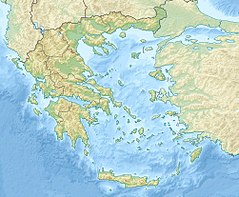Grave Stele of Dexileos
| Grave Stele of Dexileos | |
|---|---|
Pentelic marble | |
| Size | 1.86 metres (6 ft 1 in) tall |
| Writing | Epitaph in Greek |
| Created | Circa 394 BC |
| Discovered | 1863 |
| Present location | Dipylon cemetery, Kerameikos, Athens, Greece |
The Grave Stele of Dexileos is the
Description
The stele is carved in high relief and depicts a cavalryman, Dexileos, mounted on a horse, charging a Spartan enemy, probably at the 394 BC
Dexileos son of Lysanias of Thorikos.
He was born in the archonship of Teisandros (i.e. year 414/3);
he died in that of Euboulides (i.e. year 394/3),
at Corinth, one of the five cavalrymen.
— Epitaph of Dexileos, cavalryman killed in Corinthian war (394 BC)[6]
This not only gives an exact date of Dexileos’s lifespan but also describes his death in battle at Corinth. The entire stele relief scene is bordered on top with a pediment adorned with acroteria, which gives it a religious aspect with reference to naiskos, a small temple in the classical order.[4]

Context
The Dexileos stele reflects Athens during a time of chaos and disorder. Following the Athenian loss of the Peloponnesian War in 404 BC, Athenian democracy was finally restored in 403 after the overthrow of the Thirty Tyrants. Athens was also facing a war with Sparta at this time, the Corinthian War. Dexileos was a young cavalryman who died at the age of twenty, which can be seen through the inscription that reveals his lifespan. Dexileos would have been an ephebe, going through his rite of passage to become a full, democratic citizen, like other Athenian men. This process included serving in the military for three years. This stele shares characteristics of two distinct ideologies in the classical period relating to death in battle; One being a very individualistic depiction glorifying the deceased and the other being an inclusion of aristocracy within Athenian democracy and depicting death as a sacrifice for the state. While this monument depicts wealthy Dexileos in triumph, bringing pride to his family, it also shows how he is part of the Athenian community, making a sacrifice of life for his people.[4][7]
Location
The Dexileos stele is one of three monuments in the Dipylon cemetery honoring Athenian warriors. One other monument, the Polyandron, honors all those soldiers who died for the city within a certain year, including Dexileos. All these soldiers' remains, including those of the elite cavalry status as well as less-wealthy foot soldiers, were mixed together, burned, and placed in the
Funerary crown
Another monument was discovered, dedicated to five Athenian cavalrymen including Dexileos. Only the crown of the public funerary monument remains, now in
Discovery
The stele was discovered by the Athenian archaeologist, art dealer and antiquities trafficker Athanasios Rhousopoulos in the spring of 1863. Rhousopoulos' excavation followed the earlier discovery on 1 January 1862 [O.S. 20 December 1861] of the funerary naiskos of Aristonautes. Along with the nearby excavation of the funerary enclosure of Agathon, the discovery of Dexileios's stele confirmed the location of the Kerameikos cemetery, which had been forgotten since antiquity.[9]
See also
- Kerameikos steles
- Dimitris Mytaras's Dexileos in Dafni metro station.
- Thracian horseman
- Funerary Stela of Demokleides - belonging to a hoplite who died, like Dexileios, in the Corinthian War.
References
- ^ ISBN 9781848322226.
- ^ "IGII2 6217 Epitaph of Dexileos, cavalryman killed in Corinthian war (394 BC)". www.atticinscriptions.com.
- ^ a b "Kerameikos P 1130 (Sculpture)". www.perseus.tufts.edu.
- ^ a b c d e "The Dexileos Stele: A Study of Aristocracy and Democracy in Greek Art". World History Encyclopedia.
- ^ "Grave Stele of Dexileos | Museum of Classical Archaeology Databases". museum.classics.cam.ac.uk.
- ^ "IGII2 6217 Epitaph of Dexileos, cavalryman killed in the Corinthian war (394 BC)". www.atticinscriptions.com.
- )
- S2CID 191411361.
- ISBN 978-0-89236-910-2.
External links
![]() Media related to Stele of Dexileos at Wikimedia Commons
Media related to Stele of Dexileos at Wikimedia Commons

